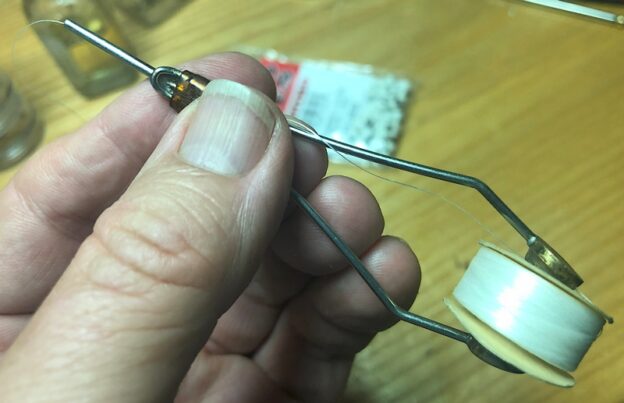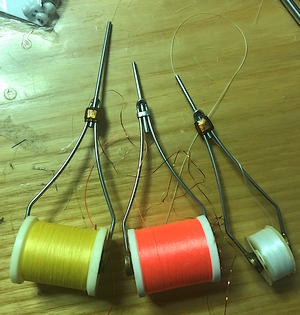Just finished tying a few dozen Clouser Minnows using the smaller sewing machine spools and a Matarelli Midge bobbin designed for the smaller spool size.
So I don’t confuse the reader I’ll need to change the nomenclature a bit. The spools for sewing machines are called “bobbins” and we call the apparatus that holds the spool a “bobbin,” which can lead to confusion on the part of the reader. I will call the sewing machine bobbins “spools” – as in sewing machine spool, to distinguish the fly tying tool from the container holding the beading thread.
Unlike sewing machine spools, which are made of steel, the NYMO beading thread is packaged on plastic spindels, with paper sides rather than metal. While the paper thread spools work, my hammy hands and their grip on the fly tying bobbin dislodged the spool from the midge bobbin frequently. I had to change my grip a bit to make these work, and once aware of the issue I was able to make them work reasonably well.
Unfortunately, additional definition is needed for what I am describing as a “midge bobbin.” Frank Matarelli made his midge bobbin expressly for the sewing machine spool size – and NOT for our traditional thread spools. Matarelli tools are no longer made, and today “midge” bobbins are typically smaller, lighter bobbins made for tying small flies using the conventional thread spool sizes.
Us old timers that still have a few midge bobbins remember how cone-based thread used to be a reality, and moving fly tying thread from one form to spools was not such an imposition. Naturally, this should “color” your view as to whether this smaller spool form of NYMO is worthwhile for your tying.
It’s likely that winding a rubber band onto the legs of traditional bobbin would close the legs enough for a sewing machine spool to work better. The extra tension afforded by the rubber band might make your current bobbin an option.
Heavy tension on the bobbin while tying can work the thread into the crevass between paper spool side and the packed thread itself. I didn’t get any tangles, but I did get a few turns of uneven tension as a result. When working with big saltwater flies this isn’t much of an issue, but could be if the thread sizes and flies tied were smaller.
In summary, there was a wee bit more bother using the paper spools due to the tier’s palm pushing the paper spool out of the grip of the bobbin’s legs. A grip adjustment was necessary so that I didn’t continually knock the spool from the grip of the bobbin legs. As this thread is 2/0 or larger, you will be tying flies commensurate with the thread size and force will likely cause issues. Be so advised.


